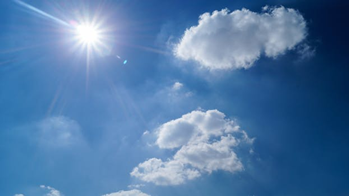Posted 2 May 2018
 The weather is getting warmer, the nights are getting longer and the summer months are fast approaching. This goes hand in hand with people wanting to spend more time outside in the sun. But did you know a single episode of sunburn every two years can increase your chances of developing skin cancer threefold? (1)
The weather is getting warmer, the nights are getting longer and the summer months are fast approaching. This goes hand in hand with people wanting to spend more time outside in the sun. But did you know a single episode of sunburn every two years can increase your chances of developing skin cancer threefold? (1)
“I don’t burn, I tan, so I’m safe!” you might say. But it’s been proven that there’s no safe or healthy way to develop a suntan either. So take note of the advice in this blog to make sure you stay safe in the sun this summer! (2)
The link between sun exposure and skin cancer
Ultraviolet (UV) light is a type of radiation found in the sun’s rays and is invisible to the naked eye. It is the component of sunlight that causes sunburn, suntan and the damage to the DNA in your skin’s cells that can lead to skin cancer. The UV light that reaches our atmosphere comprises two varieties: UVA and UVB. UVA can reach the deeper layers of the skin, whereas UVB affects the superficial layers, therefore both varieties of UV light damage the skin in different ways. (1, 2)
Skin cancer can be categorised into melanoma and non-melanoma. Around 250,000 people in the UK are diagnosed with non-melanoma annually. It is generally less serious than melanoma but can leave those affected with disfigurements, since the main treatment is to remove the affected area of skin if possible. (2)
Melanoma kills approximately 2,000 UK people annually. (2)
How to stay safe in the sun
Overall, the best way to avoid overexposure to the sun is to avoid going out in it, particularly at times when sunlight is strongest, between 11am and 3pm from March through to October. In the summer months, UV rays can filter through cloud in the above hours. If you need to go out, cover as much of the skin with clothing as possible as long as it is not too warm (for example, long sleeved tops and full length trousers), apply sunscreen to bare skin, and seek shade whenever you have the chance. Sunglasses are also important as even eyes can be damaged by sun exposure, but they must bear the CE Marking and European Standard EN 1836:2005 - if they don’t, you run the risk of having less or no eye protection, and this can be very dangerous as looking through tinted glass allows the eyes to open more widely in sunlight, meaning more harmful UV rays reach the eyes. (2)
Your sunscreen needs to offer protection against both UVA and UVB light. You can identify this by looking on the container for the letters ‘UVA’ within a circle, as well as a four star UVA protection rating or above, and SPF15 or higher. Apply sunscreen generously - around eight teaspoons’ worth as a minimum for an adult of average size, half an hour before you’re due to go outside and again immediately before you go out. Remember to cover all areas that will be exposed to the sun, including ears, neck, and the scalp if you have thinning, little or no hair - but wide-brimmed hats are more reliable for this purpose. Sunscreen should be reapplied if the skin is wet, rubbed or sweating occurs. (2)
Children’s skin is generally much more sensitive than that of adults. Up to the age of 6 months, they should not be taken outside in strong sunlight, or if it cannot be avoided, they should be shaded. For older children, it is crucial to follow the advice stated above with regard to covering the skin, seeking shade and applying sunscreen, as childhood sunburn is a major risk factor for skin cancer in later life. (2)
A ‘healthy glow’ - a common misconception
In 2016, the National Institute for Health and Care Excellence (NICE) released new guidelines stating that, contrary to popular belief, there is no safe way to tan in the sun. It might make you look healthier, but that’s as far as it goes. A suntan, just like sunburn, is a sign that potentially harmful changes have occurred in the skin. And protection from the effects of further UV exposure offered by tanned skin is negligible. Even if you have naturally dark or black skin you can still be at risk of skin cancer from overexposure to UV light. (2)
Since sunbeds also utilise UV light, often at higher concentrations than in sunlight, they are equally unsafe. If you crave darker skin as summer approaches, fake tanning products exist as a safe alternative to the sun or sunbeds. Or ideally, we can embrace our skin just the way it is! (2)
References
- Cancer Research UK. How the sun and UV cause cancer [cited 26 April 2018]. Available at: http://www.cancerresearchuk.org/about-cancer/causes-of-cancer/sun-uv-and-cancer/how-the-sun-and-uv-cause-cancer
- NHS Choices. New NICE guidelines on sun exposure warn 'tanning is unsafe' [cited 26 April 2018]. Available at: https://www.nhs.uk/news/cancer/new-nice-guidelines-on-sun-exposure-warn-tanning-is-unsafe/
Author: Gabby Gallagher MPharm
Medically reviewed by: Superintendent pharmacist Margaret Hudson BSc(Hons)MRPharmS 02/05/18
Posted in Men's Health, Womens health